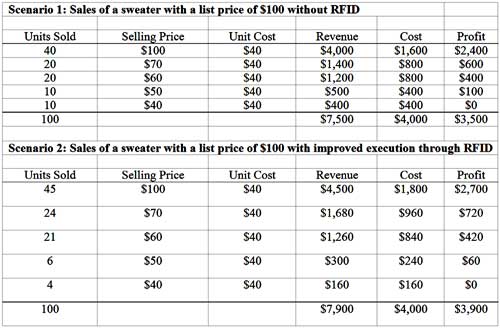Aug 10, 2009When RFID Journal and others write about using radio frequency identification to track clothing items in retail stores, we often say the technology can lead to an increase in sales of 5 percent to 10 percent. American Apparel, in fact, has reported a whopping 14 percent increase from RFID (see American Apparel RFID Project Featured in Video and American Apparel Expands RFID to Additional Stores). CEOs at retail chains seem to dismiss this as so much hype, but the reality is that not only can RFID can boost sales by 5 percent or more, most or all of that revenue increase flows to the bottom line.
I just heard CEOs collectively sigh, "Yeah, right," so allow me to explain.
We have all had the experience of walking into an apparel or department store looking to purchase a pair of jeans or kakis, only to walk out without finding our specific size. So we head on over to the next store and pick the item up there, even if it costs a few dollars more. The original retailer probably had the item in its store or distribution center, but poor execution led to a lost sale. The result, too often, is that the retailer then has to mark the item down and accept a lower profit margin.
When you think about it, this scenario plays out most often on hot items or seasonal products. As Zander Livingston, American Apparel's director of RFID, says, "When you are at your busiest, manual processes break down." Staff members are overwhelmed and can't replenish. But RFID enables retailers to achieve much greater inventory visibility, so managers can see which items are moving quickly, and which are out of stock or soon going to be. And because RFID systems enable you to confirm that items that need to be replenished have, in fact, been replenished, store managers can easily make sure that processes are being followed—even when the store is at its busiest.
Because RFID helps ensure that items are on the shelf when customers want to buy them, a retailer sells more items at or near full price. Since companies have already paid for and shipped inventory to the store, the additional revenue is all profit. Marshall Kay, founder of RFID Sherpas, wrote an excellent article for Apparel magazine a few years back that illustrated this point (see RFID: Well Within Reach). I've adapted his explanation in the chart below, which illustrates two scenarios in which a retailer sells sweaters that cost $40 for a list price of $100—with and without RFID.
Click here to view a larger version of the chart.
Some CEOs might insist they are so efficient that they can't sell many more items at a higher price. That's understandable, because store systems are telling them they are efficient. Those systems will indicate an item is in stock, but it won't reveal that it's in the wrong location on the sales floor, or in the back of the store, or that it's been stolen. A study by the University of Pennsylvania's Wharton School found that shoppers left apparel stores more than 30 percent of the time without finding at least one item they came in to buy. Thirty percent!
Improved inventory visibility through the use of RFID could enable a store to reorder hot items from a supplier more efficiently, thereby leading to incremental sales. The normal profit margin needs to be applied to the additional sales. Selling five more items at full price, with the same 60 percent margin, would lead to the same $300 increase in profits. In the current environment, most of the revenue increase is likely to come from selling more items at or closer to full price.
Even if CEOs accept that RFID can boost sales by increasing inventory visibility and improving store execution, they would probably still harbor concerns regarding the cost of such a system. Most systems integrators told me that $50,000 per store is a good rough estimate of the costs. We used $63,000 in the Fashion Retail ROI Calculator we've developed (see A New ROI Tool for Apparel and Footwear Retailers), allowing companies to adjust the costs based on their store layout; if you have two receiving doors, for instance, you can change the inputs to account for two portals. Yes, $63,000 per store can add up to a big number if you have a lot of stores. On the other hand, if the first 10 stores provide an ROI within six months, then the increase in profits can fund the rollout to additional locations.
When I plugged various numbers into the ROI Calculator, I found that for our fictional retailer, even a 3 percent increase in revenue from selling existing inventory at a higher price would lead to a return on investment on its RFID deployment in less than 12 months.
What could this mean for your business? Consider our fictional retailer. When fully operational at all stores, RFID could contribute more than $25 million to the company's bottom line after three years. I invite CEOs to try our ROI Calculator and see for themselves—and if the numbers seem too good to be true, invest $50,000 in a pilot that will give you hard numbers to put into the Calculator, so that you can determine what the chain-wide benefits will be. I think you'll find our estimates are actually conservative.
Mark Roberti is the founder and editor of RFID Journal. If you would like to comment on this article, click on the link below. To read more of Mark's opinions, visit the RFID Journal Blog or click here.



